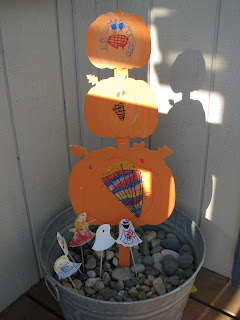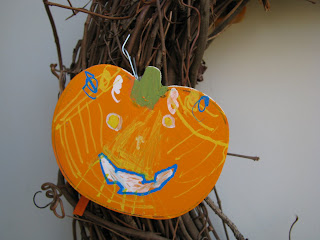I have long been an admirer of Alexander Calder and his colorful, fun whimsical work. He strikes me as someone who was a quirky and interesting person to know. He is probably most famous for his mobiles and stabiles. In fact, you really cannot teach, learn or even think about kinetic art without discussing Calder. When making mobiles, I try to replicate (in a very stretched sense) the way that Calder would balance each piece when choosing where to add the next. Little ones do not need to merely hang various lengths of string from coat hangers to make a mobile, it is much more interesting to build and balance from the bottom up.
This mobile is holiday themed and a bit on the hokey crafty side, but I think the structure redeems it. I cut out the wings and bodies. Hollin glued them together and added faces, mango trees, night vision and more. Some are flying, others sleeping. Bold colorful shapes can easily take the place of bats--actually anything can work!
We used:
5 paper bats made with black construction paper and decorated with crayons
4 pieces of wire (20 gauge) between 14" and 8" (does not need to be exact)
pipe cleaner for a hook (and extra cut of wire would work too)
hole punch
wire cutters
pliers
I pulled out some other metal bending/ working tools, but really, the pliers and cutters are all you need.
1. Gather materials and make your bats and punch a hole in each bat where you want it to hang from.
2. You will be building the mobile from the bottom up. Use your longest piece of wire and attach a bat to each end. This is the only piece of wire that will have two bats. All the others will only have one. Be careful not to tear through the paper around the hole. The pliers help make a nice loop in the wire. Pinch and close it up tight. You may need to help make sure the bats are attached securely.
3. Using your finger, find the point where the wire balances (does not slide off your finger onto the floor).
4. Make a loop in the wire in that spot.
5. Select another piece of wire. This time, attach one end to the loop you just made.
6. Carefully attach the third bat to the end of the newly attached wire.
7. Now find the balance point by placing your finger under the wire with the bat (number 3) you just attached. Make a loop in that spot. Attach the next piece of wire and then the next bat. You just keep repeating this process until you are finished.
Once you have used up all of you bats and wire, find the balance point on the top wire, add a loop and attach a hook. We hung our mobile on the light over the kitchen table. It is very light and delicate and spins around slowly and gently.

It all sounds a bit complicated but t really is not. The balancing is great fun for the little ones and a great way to throw some science into your day.
Enjoy your weekend. This may be our last snow free weekend for awhile so I think we will be playing in the leaves.


































































